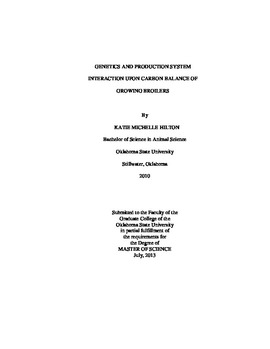| dc.description.abstract | A total of eight hundred chicks were obtained from a commercial hatchery in Siloam Springs, AR. Half of the chicks were Cobb 500 and half were Ross 308 breed. Each of the four hundred birds was composed of half male and female. Chickens for the performance study were housed in two barns to represent two separate production systems. One barn was designed to simulate a Cobb 500 breed production system, a lower protein to energy ratio and light restriction (LRLP; light restriction, low protein) and the other barn was a Ross 300 breed production system, which specified a nearly constant lighting program (23 h) and a higher dietary protein to energy ratio (CLHP; constant light, high protein). For the carbon balance study, chickens were placed into forty metabolic chambers housed in two environmentally controlled separate rooms. Each room had 20 chambers, 12 broiler chambers (28.6 X 37.4 X 44) and 8 turkey chambers (46 X 63.8 X 66). One room was designated the LRLP environment while the other was the CLHP. Body weight, feed consumption, feed conversion ratio, and carcass characteristics were determined for birds days 0-41.Birds under the CLHP treatment had greater (P<0.05) body weight. Environment had little effect on feed conversion ratio (P<0.05). On days 7, 13, 20, and 27 CLHP birds retained more (P<0.05) carbon than LRLP birds. However, on day 41, although only numerical, LRLP retained more (P>0.10) carbon than CLHP birds. Ross birds retained more (P<0.05) on days 7 and 13. However, on day 41, Cobb birds retained 1% more (P>0.10) carbon than Ross birds. On days 7, 13, and 20, with CLHP birds produced more (P<0.05) gaseous carbon versus the LRLP birds and Ross birds produced more (P<0.05) gaseous carbon. On days 7, 13, and 20, CLHP birds excreted 12% more (P<0.05) carbon than LRLP. Little differences were seen on day 41, but lighting must be a factor in overall carbon emissions. Therefore, raising Cobb breed males under light restriction and lower protein diet will produce a viable product in efficient time with a decrease in greenhouse gas emissions. | |
